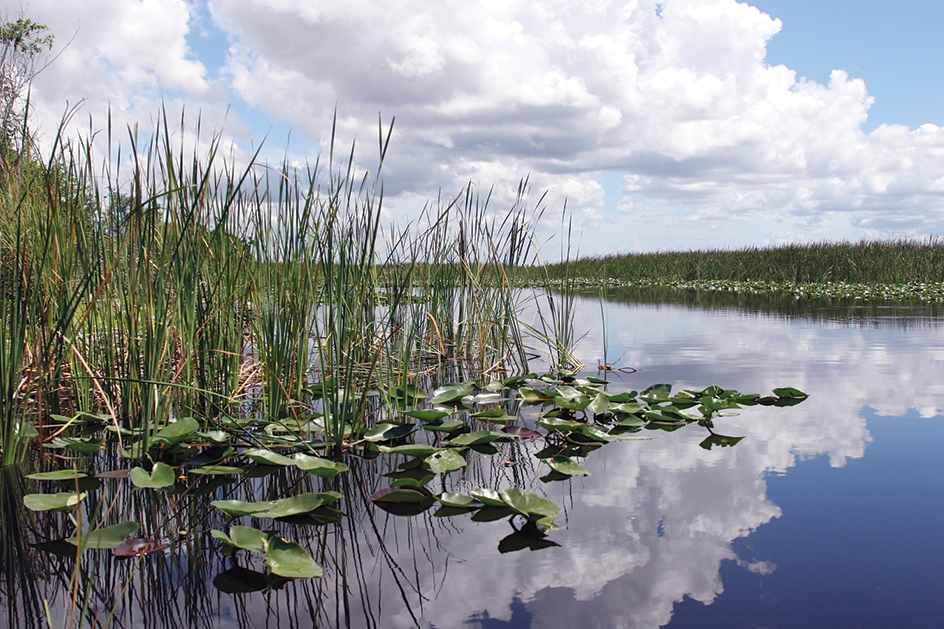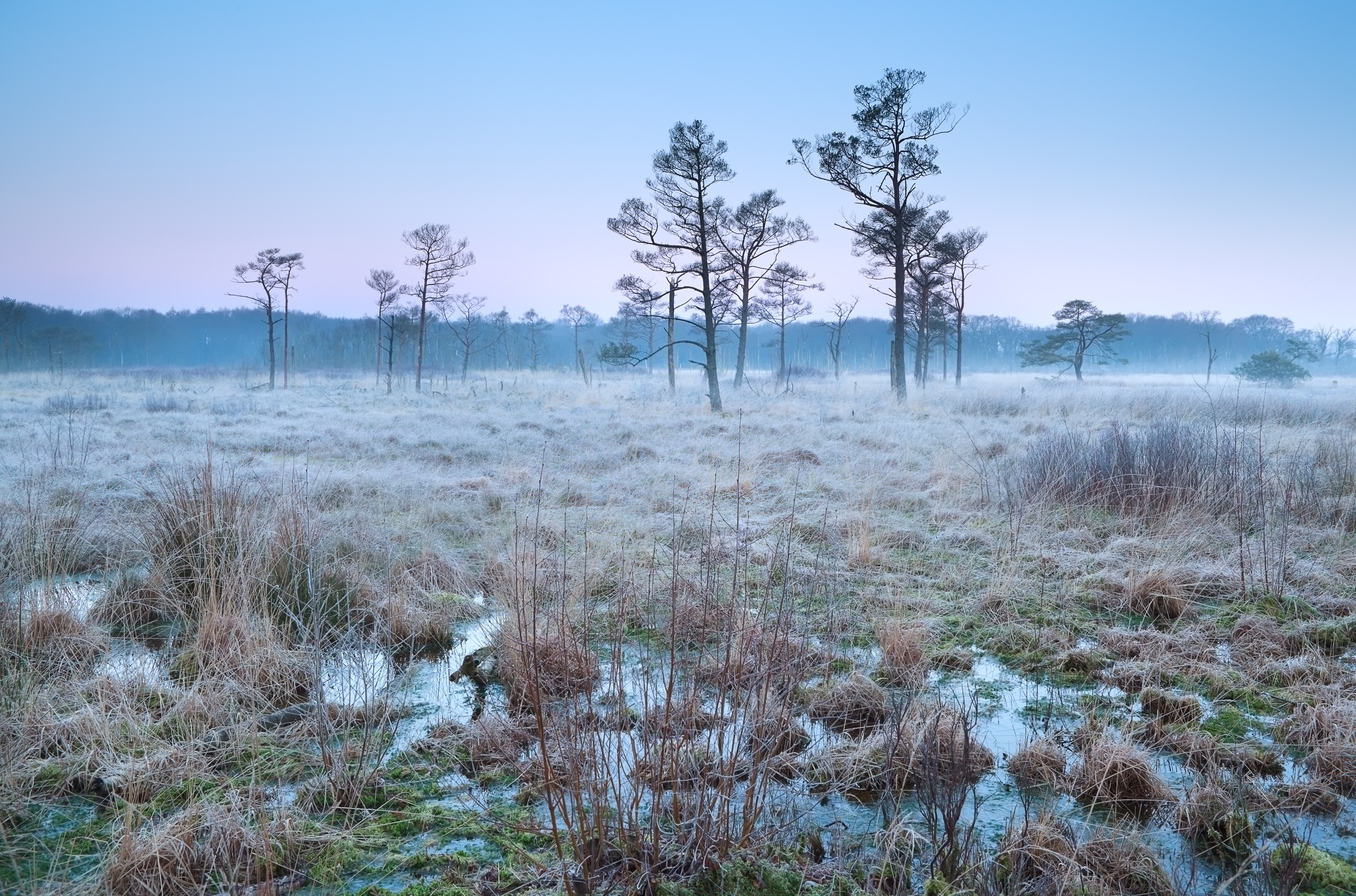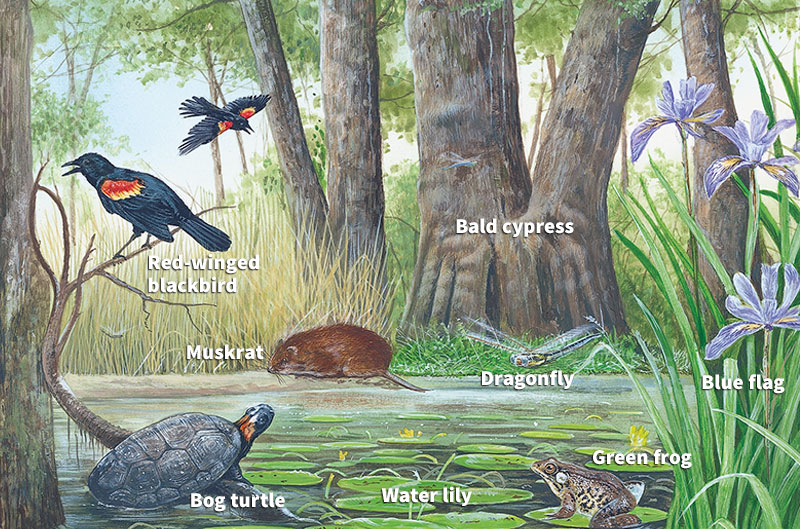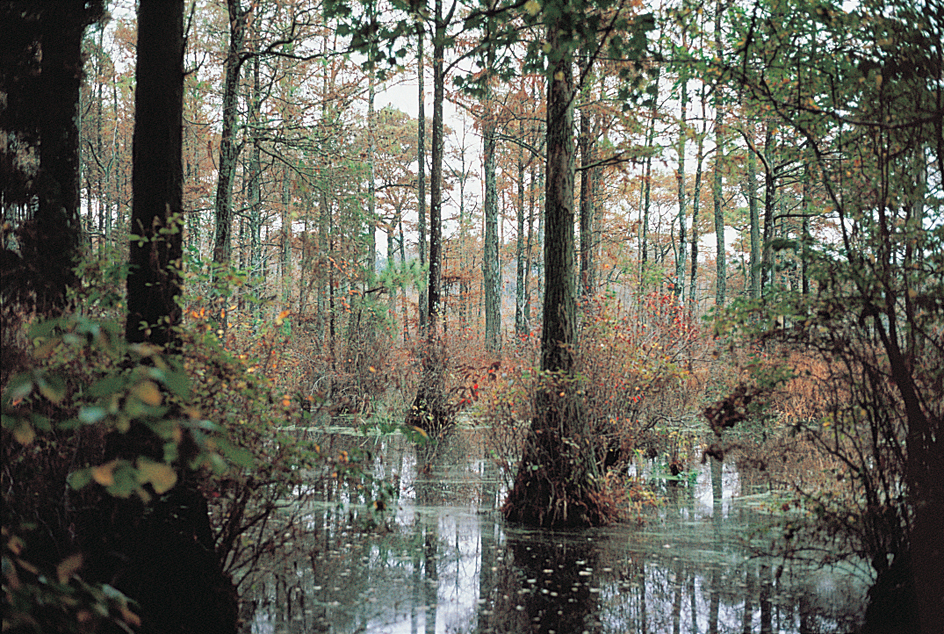Wetland is an area of land where the ground remains soaked with water or submerged beneath it for most of the year. Wetlands occur throughout the world near lakes, ponds, and rivers and along sea coasts.

Many organisms depend on the unique conditions found in wetlands for their survival. Wetlands plants have evolved (developed over time) to thrive in the water-soaked soil. Such plants can live only in wetlands. Many animals spend much of their lives in wetlands—including alligators, ducks, hippopotamuses, and muskrats. Other animals reproduce in wetlands or visit them to find food, water, or shelter.
Wetlands environments vary widely in character. Some wetlands, such as marshes and wet meadows, resemble flooded grasslands. Swamps are watery forests. Aquatic beds have plants that float on the surface of water. A spongy mat of peat (partly decayed plant material) covers the ground in wetlands called bogs and fens.
Wetlands provide many important benefits to people. They can absorb some flood waters, protecting people and property from harm. They also replenish ground water (water held beneath the ground), which can be used as a water supply. But people have destroyed many wetlands to make room for cities, farms, and roads. Many governments and conservation groups are working to preserve wetlands.
Water and soil
Wetlands form where the soil is saturated with water for a significant portion of the year, especially where it is saturated during growing season. Inland wetlands generally contain fresh water and occur around lakes, ponds, and streams. Coastal wetlands contain a mixture of salty ocean water and fresh water from inland.

Not all wetlands are permanently flooded. In some wetlands, the water level varies from season to season, depending on rainfall. In coastal wetlands, tides can cause the water level to rise and fall over the course of a day. Smaller tidal variations can occur in freshwater wetlands along rivers near the oceans.
Wetlands have hydric soil, a type of soil that forms under extremely wet conditions. Hydric soil is anaerobic—that is, lacking in oxygen—and often smells like rotten eggs. It may also be gleyed, taking on a dark gray appearance, or mottled with orange-brown spots.
Wetland soils often contain more organic material—such as the remains of leaves, twigs, and dead animals—than is found in more oxygen-rich soils. Bacteria, fungi, and other organisms generally decompose (break down) organic material. But these organisms require oxygen to do so efficiently. The anaerobic conditions in hydric soil slow decomposition, causing organic material to accumulate.
Some wetlands have soil composed of such minerals as clay, sand, and silt, much like the soils found in dry land regions. In other wetlands, however, decomposition occurs so slowly that the remains of dead plants and animals accumulate as thick mats of peat. Wetlands called peatlands have soil composed chiefly of peat instead of minerals.
Wildlife
Wetlands are home to a variety of living things. These organisms include plants adapted to oxygen-poor soils and the animals that feed on them or live among them.
Plant life.
The roots of most plants require soils with oxygen and so cannot survive long in anaerobic wetland soils. Wetland plants have evolved special adaptations to help their roots obtain oxygen.

The roots and stems of some wetland plants consist of aerenchyma, a tissue that contains large air spaces. In these plants, oxygen in the air is absorbed through the leaves and stems. The oxygen is then transferred to the roots through the air spaces in the aerenchyma.
Some wetland trees, such as mangroves and baldcypress, have special woody roots called pneumatophores. These roots extend above the water surface and give the trees the appearance of being elevated on bent knees or stilts. Pneumatophores help support the trees in unstable wetland soils, and in mangroves they also absorb oxygen from the air.
Plants usually obtain nitrogen, an essential nutrient (chemical needed for growth), from the soil. But hydric soils often have little nitrogen. Certain plants, called carnivorous plants, obtain extra nitrogen by trapping insects and other small animals and digesting their nitrogen-rich bodies. Many carnivorous plants live in freshwater wetlands.
Animal life.
Many animals make their homes in wetlands. Beavers, bog turtles, and water spiders spend most or all of their lives in wetlands. Other animals divide their time between wetlands and the surrounding areas. Such animals include dragonflies, tree frogs, and red-winged blackbirds.
Many fish live in wetlands or use them for spawning (laying eggs) or for the protection of young. The mudskipper is one of the most unusual wetland animals. This fish can spend long periods out of water and can climb up the branches and trunks of mangrove trees. 
Certain animals do not actually live in wetlands but often visit them to find food or water. Deer, elephants, foxes, and lions depend on wetlands in this way.
Types
Scientists usually classify wetlands according to several factors. They include a wetland’s water chemistry and water level, its soil composition, and the kinds of plants that live there.
Aquatic beds
are wetlands where herbaceous (nonwoody) plants grow underwater or on the surface of water. Bladderworts, eelgrass, Elodea (waterweed), milfoil, and water celery grow submerged in water. Other plants in aquatic beds have leaves that float on the surface of the water. These include duckweed, spatterdock, water lilies, and water shield. Water-meal, the smallest flowering plant, often occurs in aquatic beds. It grows to about 1/25 inch (1 millimeter) in length.
Bogs and fens
are two types of peatlands. Bogs have acidic soils and few mineral nutrients. Fens have slightly acidic or basic soils with a higher level of nutrients. Peatlands may be dominated by mosses, trees, or grasslike sedges. Peat mosses and carnivorous plants are especially common in bogs.
Marshes and wet meadows
are wetlands where herbaceous, grasslike plants grow above the water surface. Freshwater marshes are usually flooded with shallow, standing water. In coastal marshes, tidal activity causes constant changes in the water level. Typical marsh plants include bulrushes, cattails, common reeds, cord grass, and saw grass.
Wet meadows, unlike marshes, are flooded for only brief periods each year and have drier soil. Plant life in wet meadows commonly consists of grasses and sedges. These wetlands appear much like dry meadows.
Swamps
are wetlands where shrubs and trees are the most common plants. Typical freshwater swamp trees include baldcypress, larch, and water tupelo. Mangroves dominate in coastal swamps. Alder, highbush blueberry, swamp azalea, and sweet pepperbush are common shrubs in freshwater swamps. Swamps have standing water for part of the year but are not usually permanently flooded.

Preservation
Wetlands connect aquatic (watery) and terrestrial (dry land) environments. As such, they form an important and unique type of ecosystem. An ecosystem consists of a group of living things, their environment, and the relationships among both. The soil conditions in wetlands produce a large amount of plants and plant material, which is in turn consumed by many animals. Migrating birds use wetlands as resting places. Many endangered plants and animals can survive only in wetlands.
Wetlands are also important to human beings. Because they can absorb large amounts of water, wetlands help control flooding. Wetlands also help to replenish ground water supplies. Nevertheless, people have polluted and destroyed a large percentage of wetlands throughout the world. Many individuals and governments have realized the importance of wetlands, but preserving wetlands remains an ongoing challenge.
Threats.
People throughout history have viewed wetlands as obstacles to be cleared away. They drained wetlands to make room for cities, dams, and farms and to get rid of mosquitoes. In the continental United States, for example, human activity has destroyed more than half of the wetlands that existed in 1800. Some states have lost more than 80 percent of their original wetlands.
Those wetlands that have escaped intentional destruction face a number of threats. Salt and oil drain into wetlands from roads. Harmful chemicals and pesticides from farms accumulate in wetlands. Native wetland plants and animals are threatened by invasive species—that is, animals and plants introduced from other areas. Even noise and light from cities can harm wetland ecosystems by disturbing natural patterns of animal behavior. Global warming may cause sea levels to rise, drowning coastal wetlands.
Conservation.
Many governments have passed laws that protect wetlands. In the United States, for example, many wetlands serve as habitats for endangered species and thus are legally protected under the Endangered Species Act of 1973. Because wetlands often blend into adjacent aquatic and terrestrial areas, protecting them often begins with wetland delineation. In this process, experts determine the boundaries of a wetland based on an analysis of its soil, plant life, and water. Doing so enables the government to establish buffer zones around legally protected wetlands in which harmful activities are prohibited.
Wetlands are protected internationally by the Ramsar Convention on Wetlands, which was adopted in 1971. The convention encourages conservation and wise use of wetlands and other natural resources. Over 150 countries have joined the convention and designated hundreds of areas as important wetlands.
